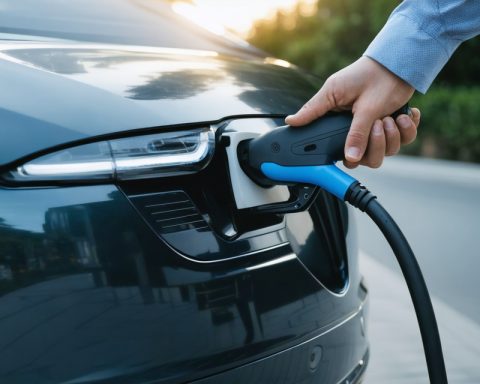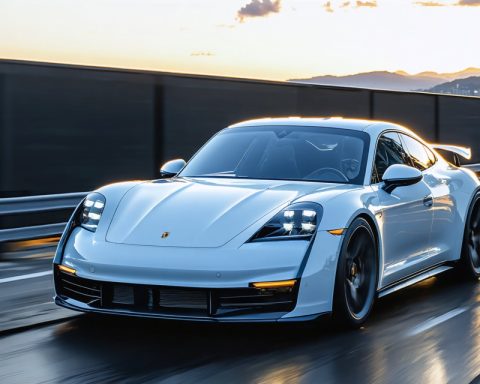- Electric vehicles (EVs) are transforming urban environments by reducing noise and air pollution, leading to cleaner cities with clearer skies.
- Infrastructure is adapting to accommodate EVs, with gas stations evolving into charging hubs that may include cafes and social spaces.
- Smart grids and advanced traffic systems optimize energy usage and reduce congestion, resulting in more efficient and fluid city travel.
- EV innovation supports sustainability efforts, with advances in battery recycling and reuse contributing to closed-loop energy systems.
- The rise of EVs signifies a broader shift towards sustainable, adaptive, and interactive urban living environments.
- Electrification is helping cities reduce their carbon footprint, ensuring clean and livable environments for future generations.
Amidst the skyline of tomorrow’s cities, a silent revolution is underway—electric vehicles (EVs) are reshaping the very fabric of our urban environments. As you walk down a bustling street, the familiar rumble of diesel engines fades, replaced by the gentle whir of electric motors gliding smoothly along the roads. This transformation is not just about replacing traditional cars with shiny new electric models; it’s about reimagining city living altogether.
Cleaner Air, Brighter Skies
The shift to electric is more than just quiet roads; it’s clearer air. Urban centers, suffocating under blankets of smog, now stand to breathe freely. EVs emit zero tailpipe pollutants, slashing urban air pollution and its deadly health effects. Imagine the vibrant blue sky mirrored in glass skyscrapers, parents strolling with babies unbothered by the nasty cough-inducing cloud of fumes. It’s a cleaner world, tangible to those who walk its streets.
Redesigning Spaces
As EVs take center stage, infrastructure bends to meet their needs. Gas stations transform into sleek charging hubs, inviting workspaces, or social centers where cars and people recharge in harmony. Picture your favorite café attached to a charging station, sipping a latte while your car powers up for the next journey. Parking garages evolve into multi-functional complexes, supporting solar-panel canopies and green rooftop gardens.
Intelligent Infrastructure and Seamless Mobility
Cities gear up with smart grids, optimizing energy distribution to meet EV demand without strain. Advanced traffic systems reduce congestion by synchronizing with vehicle systems, turning gridlocks into a thing of the past. Vehicles communicate with traffic lights and smart signs, ensuring your drive is not just quicker but almost poetic in its fluidity. Imagine driving through a metropolis that anticipates your car’s needs, adapting roads and traffic patterns in real-time.
Sustainability Meets Innovation
Electric vehicle innovation spurs broader sustainability efforts. Batteries, once deemed toxic waste, become champions of recycling and reuse. Companies invest heavily in research, ensuring every joule of energy used is part of a closed, green loop. Envision a future where your child plays in parks free from pollution, their toys powered by the sun, vehicles, and household batteries harmonizing to power cities sustainably.
Takeaway
The rise of electric vehicles is not just an automotive trend but a catalyst for comprehensive urban change. As EVs permeate city streets, they herald an era of cleaner air, innovative infrastructure, and sustainable living. The cities of the future won’t merely exist; they will breathe, adapt, and interact with their inhabitants like never before. Embrace this electric transformation—it’s more than transportation; it’s a path to a vibrant, sustainable tomorrow.
By investing in electrification, cities are not just reducing their carbon footprint; they’re ensuring a legacy of clean, smart, and livable environments for generations to come. An electric future promises not just progress in technology but a rebirth in the essence of urban life itself. Are you ready to join the revolution?
The Electric Revolution: How EVs Are Transforming Urban Living
The rise of electric vehicles (EVs) is heralding a new era in urban lifestyles, altering not only how we travel but also how cities function and evolve. The ripple effects of widespread EV adoption go beyond transportation, influencing environmental quality, city planning, infrastructure, and sustainable living. Here’s a dive into additional insights, real-world use cases, and future trends related to this electrifying shift.
Expanding on Cleaner Air, Brighter Skies
– Health Benefits: Beyond reducing smog, lower pollution levels contribute to decreased rates of respiratory illnesses and cardiovascular diseases. According to a study by the European Environment Agency, cities could experience a significant drop in air-pollution-related premature deaths (source: EEA).
– Global Emission Reduction: As of 2023, transportation accounts for about 24% of global CO2 emissions (source: IEA). Widespread EV adoption would dramatically cut this figure, aiding global climate goals.
Redesigning Urban Spaces
– Integration with Renewable Energy: Charging stations increasingly incorporate solar panels, storing energy in vehicle-to-grid systems. This not only supports sustainable energy use but also contributes to decentralizing the energy grid, boosting resilience against outages.
– Shared Mobility Hubs: Shared EV programs are on the rise, offering convenient alternatives to personal car ownership. Companies like Zipcar and Share Now are expanding their fleets to include more electric options, promoting a more sustainable car-sharing culture.
Intelligent Infrastructure and Seamless Mobility
– AI and Machine Learning: Smart city initiatives utilize AI to predict traffic patterns, manage energy distribution, and streamline public transit systems. Cities like Singapore and Amsterdam are leading the way in integrating smart technologies to enhance urban mobility (source: SmartCitiesWorld).
– 5G Connectivity: The deployment of 5G networks enables real-time vehicle-to-everything (V2X) communication, advancing autonomous driving capabilities and reducing traffic congestion.
Sustainability Meets Innovation
– Battery Recycling: Companies are advancing battery recycling processes to recover critical minerals like lithium, cobalt, and nickel. This reduces dependency on mining and supports a circular economy.
– Second-Life Batteries: Used EV batteries find new life in storage applications, stabilizing power grids or providing backup power in homes and businesses.
Addressing Common Concerns
What About Charging Infrastructure?
– Expansion Plans: Companies and governments are deploying fast-charging stations along highways and urban areas. The EV charging market is projected to grow at a CAGR of 29% from 2023 to 2030 (source: MarketsandMarkets).
How Do EVs Compare Economically?
– Cost Efficiency: While upfront costs can be higher, EVs generally have lower running costs due to reduced fuel expenses and lower maintenance needs. The total cost of ownership is increasingly competitive compared with internal combustion engine (ICE) vehicles.
Are There Environmental Considerations in Manufacturing?
– Sustainable Sourcing: Manufacturers are improving the sustainability of their supply chains, focusing on reducing emissions during production and sourcing raw materials responsibly.
Actionable Recommendations
1. Explore Incentives: Check for government incentives or rebates for EV purchases in your region. These can significantly reduce the initial cost.
2. Plan for Charging: If you’re considering an EV, research local charging infrastructure and plan any necessary home charging setup.
3. Stay Informed: Keep abreast of updates in battery technology and smart city developments to maximize the benefits of your EV investment.
4. Join Car-Sharing Programs: If ownership isn’t feasible, explore car-sharing services that offer EVs as a green alternative.
The shift towards EVs promises not just a cleaner and more efficient form of transportation but a redefinition of urban living itself. From economic benefits to advanced city planning, the electric revolution is set to reshape our world. Are you ready to embrace the change?
For more insights on smart technologies and urban planning, visit SmartCitiesWorld and IEA.












